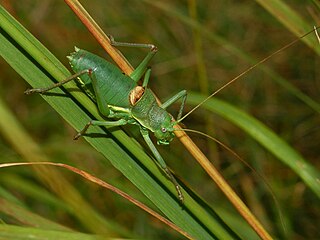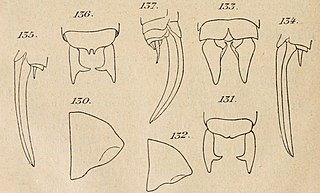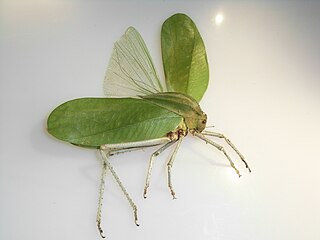
Oswald Duda, full name Pavel Theodor Friedrich Oswald Duda was a German entomologist mainly interested in Diptera.

Mario Bezzi was an Italian professor of zoology at the University of Turin. He was also director of the Turin Museum of Natural History. He was a Doctor of Science.
Antoine Henri Grouvelle was a French entomologist who specialised in Coleoptera. He was also an engineer who directed a tobacco factory. He worked on world fauna of the heterogeneous group of beetles known as Clavicornia. Grouvelle was a Member of the Société entomologique de France
Heinrich Hugo Karny was an Austrian physician and entomologist who specialised in Thysanoptera and Orthoptera.
Cesare Maria Tapparone-Canefri was an Italian malacologist.

Phasia aurigera is a species of tachinid fly.
Emilio Berio was an Italian entomologist and lawyer.

Mecopodinae are a subfamily of bush crickets found in western South America, sub-Saharan Africa, and Asia. In Asia, the distribution includes India, Indochina, Japan, the Philippines, and Malesia to Papua New Guinea and Australasia, including many Pacific islands.
Holopelus is a genus of crab spiders that was first described by Eugène Louis Simon in 1886.

Agraeciini is a large tribe of bush crickets or katydids in the conehead subfamily, Conocephalinae.
Antonio Giordani Soika was an Italian entomologist, ecologist and director of the Civic Museum of Natural History of Venice. He had a long career in which he worked on various groups of insects but much of his work was on the Hymenoptera. He made great contributions to the knowledge of Neotropical wasps, especially potter wasps for which he produced many taxonomic keys and also monographs on the systematics of the wasp family Vespidae.

Ephippiger perforatus, the North Apennine saddle bush-cricket, is a species of insect in the family Tettigoniidae.

The Coptacrinae are a subfamily of Acrididae in the Orthoptera: Caelifera. Species can be found in Africa and Asia.

Gryllotalpa unispina is a species of mole cricket, in the G. gryllotalpa species group, found in Eastern Europe through to Manchuria. No subspecies are listed in the Catalogue of Life.
Zulpha is a monotypic genus of bush crickets containing only the species Zulpha perlaria.

Orophus tessellatus, the false leaf katydid, is a species of katydid native to Mexico, Central America, and South America. It is in the large subfamily Phaneropterinae within the tribe Amblycoryphini. Its coloring varies from brown to green, some with spots, mottling, or uniform in coloration. The body length reaches 16 mm (0.63 in) in males and 22 mm (0.87 in) in females. The ovipositor is approximate 7 mm (0.28 in) in length. The species is characterized by the size of the forewings and their "dirty" coloring.
Neanias is a genus of Orthopterans, sometimes known as 'leaf-folding crickets' in the subfamily Gryllacridinae and tribe Gryllacridini. The recorded distribution is: Indian subcontinent, Japan, Hainan, Indochina, and western Malesia (Sumatra).

Conocephalus conocephalus is the type species of the conehead genus Conocephalus and the bush cricket tribe Conocephalini. This species has been recorded from southern Europe, including France, and Africa. Described by Carl von Linné in 1767, C. conocephalus appears to have no surviving type specimens, although it is believed that material may have been obtained from Africa.

Anisolepis grilli, commonly known as Boulenger's tree lizard and papa-vento-do-rabo-rajado in Brazilian Portuguese, is a species of lizard in the family Leiosauridae. The species is endemic to South America.

Siliquofera is a genus of bush cricket in the subfamily Phyllophorinae that includes only one species, Siliquofera grandis, which is fairly common and widespread in rainforest canopies of New Guinea and nearby smaller islands, and seemingly rare in Australia where only found in the remote Iron Range region. This very well-camouflaged, green and leaf-like bush cricket is one of the world's largest Orthoptera, with adults typically having a length of 10.7–13 cm (4.2–5.1 in) and a wingspan of 25–27 cm (9.8–10.6 in); it can weigh more than 30 g (1.1 oz).












